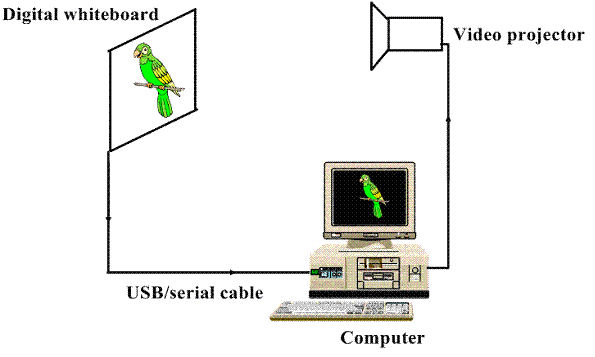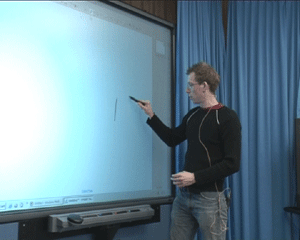6. Using Interactive Whiteboards
This document gives a brief overview of the different functions of the software
that accompanies interactive whiteboards. The document is meant as a general introduction,
independent of the different brands of interactive whiteboards. And even though there are two
different types of interactive whiteboards (pressure-sensitive whiteboards and normal whiteboards
equipped with sensors), the software that accompanies them have basically the same
functionality, and so this overview is independent of the type of whiteboard used.
We start by describing how pressure-sensitive and sensor-equipped whiteboards work, respectively.
How a pressure-sensitive digital whiteboard works
A pressure-sensitive digital whiteboard needs a computer and a video projector to function. The
diagram below shows how the whiteboard, the computer and the video projector are connected:

The touch-sensitive surface of the whiteboard detects e.g. a pen stroke on the whiteboard, and sends
a signal to the computer via an USB or serial cable. The computer then relays the signal to the
video projector, which draws the pen stroke accordingly on the whiteboard. Without the video projector,
your drawings and writing will be "invisible".
Aligning/calibrating a pressure-sensitive whiteboard
The surface of the whiteboard needs to be aligned or calibrated with respect to the video
projector. This is done by lining up the video projector, and then pressing a pen against a
grid of points on the screen. Failure to calibrate the interactive whiteboard causes the computer
to draw the pen stroke in the wrong place.

The pen tip must be pressed at the center of some distict targets over the screen.
A wrongly calibrated whiteboard is shown in the picture below. The line is visualized severel
inches to the left of where it was drawn.

It is best to calibrate the whiteboard at the start of every session, as the process
only takes 15 seconds or so.
How normal whiteboards equipped with sensors work
The second type of interactive whiteboard is a normal whiteboard equipped with ultrasonic or infrared
sensors that detect signals from a transmitter inside a custom-made whiteboard pen. The transmitter is
activated when the pen tip is pressed against the whiteboard surface.

Here we see the pen with with the built-in transmitter, which is activated when the pen is pressed
against the whiteboard. To the left we see the ultrasonic sensor attached to the whiteboard.
Any text written on the physical whiteboard is sent by a USB or serial cable to the computer, as
shown in the picture below:

The text "HELLO" is written on the whiteboard and is immediately transferred to the software on the
computer.
This type of interactive whiteboard can also be calibrated by a procedure similar to that of a
pressure-sensitive whiteboard.
Notes can be saved on the computer, and exported to a number of different formats.
In the section New possibilities with digital whiteboards in Course 4 there are both text and video
presentations that describe how to use the interactive whiteboard.
Basic use include the following operations:
- writing text and drawing figures
- use of basic geometric shapes
- importing graphics
- exporting documents
- use of the gallery
|

